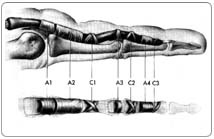What is it?
A tendon is a strong cord which joins a muscle to a bone. It enables the bone to move when the muscle contracts. There are two tendons that run on the palm side in each finger. One tendon goes to your finger tip and bends the end joint. The other goes to the middle bone and bends the first finger joint. The tendons run in a narrow tunnel. One or both of your tendons are cut. If your tendons do not get repaired, you will not be able to bend your finger.
The Operation
 You will have a general anaesthetic, and will be asleep for the whole operation. The cut in your finger is lengthened. The surgeon may need to make an extra cut in your palm. This is so he can find the ends of your cut tendon. The tendons are sewn together with fine stitches. If one of the nerves that allows you to have feeling in your finger has been cut, it will be repaired. The skin wound is then closed up with stitches. You will be in hospital three or four days after the operation.
You will have a general anaesthetic, and will be asleep for the whole operation. The cut in your finger is lengthened. The surgeon may need to make an extra cut in your palm. This is so he can find the ends of your cut tendon. The tendons are sewn together with fine stitches. If one of the nerves that allows you to have feeling in your finger has been cut, it will be repaired. The skin wound is then closed up with stitches. You will be in hospital three or four days after the operation.
Any Alternatives
If you leave things as they are, the tendons will not heal properly. You will lose a lot of the use of your finger.
Before the operation
You will have come to the hospital as an emergency. You need to let the doctors and nurses know about your general health, past illnesses, and drug treatment. Arrangements will be made for you to have the operation within 24 hours or so of the injury. You will have all the necessary tests to make sure that you are well prepared and that you can have the operation as safely as possible.
After - In Hospital
Your arm will be in a plaster cast from below the elbow to the finger tips. The wound may be painful. You will be given injections or tablets to control this. Ask for more if the pain gets worse. A general anaesthetic will make you slow, clumsy and forgetful for about 24 hours. The nurses will help you with everything you need until you are able to do things for yourself. Do not make important decisions during this time. The tendons are repaired with fine stitches. These stitches are not very strong. Too much force too early will pull the tendon ends apart. The tendons must continue to slide in their tunnel while they heal. If they stay still while they heal, the tendons stick to the walls of the tunnel and never slide again. Too little movement of the healing tendon will stop the tendon sliding in its tunnel.
The exercises that you do after your operation are a vital part of your recovery. The physiotherapist will show you what exercises to do. If your cut is only in the palm, you begin exercises on the first day after your operation. If your cut is in your finger, you begin exercises on the second day after your operation. Your stitches will be taken out when you come to the outpatient clinic 10 to 12 days after the operation. You will not need a dressing on the wound after that. You will need a plaster cast or splint on the back of your hand for about six weeks after your operation. Wash around the plaster for the first 10 days. You can wash the wound area as soon as the dressing has been removed. Soap and warm tap water are entirely adequate. Salted water is not necessary. You can shower or take a bath as often as you like. The nurses will advise about sick notes, certificates etc.
After - At Home
Looking after a plaster cast:
- Do not press on the plaster for 48 hours.
- Do not let the plaster cast get wet.
- Do not cut or bang the plaster.
- Do not put anything down the inside of the plaster (eg coins).
- Do not use anything to scratch under the plaster.
Come back to the hospital if:
- you have pins and needles or numbness in your fingers.
- you cannot move your fingers.
- your fingers go blue.
- your fingers become very swollen.
- you have severe pain.
If you are experiencing one or more of these problems it could be an indication of a problem with the nerves or the blood vessels in or around the area of the operation or of an infection. In this case you need to return to the hospital urgently.
Come back to see the plaster technician if the plaster cracks ,becomes soft or is getting loose.
You must not drive whilst your arm is in a plaster cast. You should not drive for about 10 weeks after the operation to allow your tendons to heal fully. How soon you can return to work depends on your job. If you can work one handed, you may be able to return to work two weeks after the operation. This also depends on you being able to get to work. If your job is manual you will be unable to work for three or four months.
You may swim six weeks after your operation. You may play most sports 10 weeks after your operation. When you start playing, you will not be able to play for as long as normal. Your hand will ache at the end of a game. Your finger movements and strength will continue to improve for up to six months. If you have had repair of a cut nerve, you should begin to have some feeling in your finger about six weeks after your operation. You may go through a period of up to six months when the finger is extra sensitive. This passes. The sense of touch in your finger will improve for up to three years. The feeling will never be normal, it will be different.
Possible Complications
As with any operation under general anaesthetic there is a very small risk of complications related to your heart or your lungs. The tests that you will have before the operation will make sure that you can have the operation in the safest possible way and will bring the risk for such complications very close to zero.
Wound infection sometimes happens. You will be given antibiotics to try and prevent this. More serious complications like damage to the blood vessels or the nerves in or around the area of the operation happen rarely and you might need another operation to fix them. The tendon is at its weakest two weeks after it has been repaired. Occasionally, the tendon repair can come apart. If this occurs, you will suddenly be unable to bend your finger. Go straight to the casualty department and you will be re-admitted for a second repair. The nerve may not heal. This leaves part of your finger permanently numb.
Advanced Reproductive Technology
- In Vitro Fertilisation (IVF)
- Intracytoplasmic Sperm Injection (ICSI)
- Donor egg and embryo programs
- In Vitro Fertilisation (IVF)
- Pre-implantation genetic diagnosis (PGD)
- Surrogacy programs
Dental Videos





